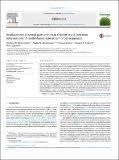| dc.contributor.author | McCormick, Alethea W. | |
| dc.contributor.author | Abuelezam, Nadia Natasha | |
| dc.contributor.author | Fussell, Thomas | |
| dc.contributor.author | Seage, George R. | |
| dc.contributor.author | Lipsitch, Marc | |
| dc.date.accessioned | 2018-05-18T20:33:50Z | |
| dc.date.issued | 2017 | |
| dc.identifier | Quick submit: 2018-04-10T14:55:09-0400 | |
| dc.identifier.citation | McCormick, Alethea W., Nadia N. Abuelezam, Thomas Fussell, George R. Seage, and Marc Lipsitch. 2017. “Displacement of Sexual Partnerships in Trials of Sexual Behavior Interventions: A Model-Based Assessment of Consequences.” Epidemics 20 (September): 94–101. doi:10.1016/j.epidem.2017.03.007. | en_US |
| dc.identifier.issn | 1755-4365 | en_US |
| dc.identifier.uri | http://nrs.harvard.edu/urn-3:HUL.InstRepos:37034619 | |
| dc.description.abstract | We investigated the impact of the displacement of sexual activity from adherent recipients of an intervention to others within or outside a trial population on the results from hypothetical trials of different sexual behavior interventions. A short-term model of HIV-prevention interventions that lead to female rejection of male partnership requests showed the impact of displacement expected at the start of a trial. An agent-based model, with sexual mixing and other South African specific demographics, evaluated consequences of displacement for sexual behavior interventions targeting young females in South Africa. This model measured the cumulative incidence among adherent, non-adherent, control and non-enrolled females in a hypothetical trial of HIV prevention. When males made more than one attempt to seek a partnership, interventions reduced short-term HIV infection risk among adherent females, but increased it among non-adherent females as well as controls, non-enrolled (females eligible for the trial but not chosen to participate) and ineligible females (females that did not qualify for the trial due to age). The impact of displacement depends on the intervention and the adherence. In both models, the risk to individuals who are not members of the adherent intervention group will increase with displacement leading to a biased calculation for the effect estimates for the trial. Likewise, intent-to-treat effect estimates become nonlinear functions of the proportion adherent. | en_US |
| dc.language.iso | en_US | en_US |
| dc.publisher | Elsevier BV | en_US |
| dc.relation.isversionof | doi:10.1016/j.epidem.2017.03.007 | en_US |
| dash.license | LAA | |
| dc.title | Displacement of sexual partnerships in trials of sexual behavior interventions: A model-based assessment of consequences | en_US |
| dc.type | Journal Article | en_US |
| dc.date.updated | 2018-04-10T18:55:11Z | |
| dc.description.version | Version of Record | en_US |
| dc.relation.journal | Epidemics | en_US |
| dash.depositing.author | Lipsitch, Marc | |
| dc.date.available | 2017 | |
| dc.date.available | 2018-05-18T20:33:50Z | |
| dc.identifier.doi | 10.1016/j.epidem.2017.03.007 | * |
| dash.contributor.affiliated | Abuelezam, Nadia | |
| dash.contributor.affiliated | Seage, George | |
| dash.contributor.affiliated | Lipsitch, Marc | |


